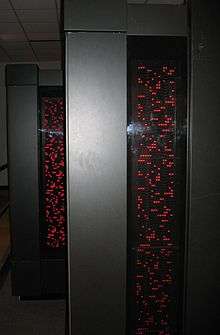Blinkenlights



Blinkenlights is a hacker's neologism for diagnostic lights usually on the front panels on old mainframe computers, minicomputers, many early microcomputers, and modern network hardware.
Etymology
The Jargon File provides the following etymology:[1]
This term derives from the last word of the famous blackletter-Gothic sign in mangled mock German that once graced many computer rooms in the English-speaking world. One version ran in its entirety as follows.
- ACHTUNG!
- ALLES TURISTEN UND NONTEKNISCHEN LOOKENPEEPERS!
- DAS KOMPUTERMASCHINE IST NICHT FÜR DER GEFINGERPOKEN UND MITTENGRABEN! ODERWISE IST EASY TO SCHNAPPEN DER SPRINGENWERK, BLOWENFUSEN UND POPPENCORKEN MIT SPITZENSPARKEN.
- IST NICHT FÜR GEWERKEN BEI DUMMKOPFEN. DER RUBBERNECKEN SIGHTSEEREN KEEPEN DAS COTTONPICKEN HÄNDER IN DAS POCKETS MUSS.
- ZO RELAXEN UND WATSCHEN DER BLINKENLICHTEN.
This silliness dates back to least as far as 1955 at IBM and had already gone international by the early 1960s, when it was reported at the University of London's ATLAS computing site. There are several variants of it in circulation, some of which actually do end with the word blinkenlights.
Although the sign might initially appear to be in German and uses an approximation of German grammar, it is composed largely of words that are either near-homonyms of English words or (in the cases of the longer words) actual English words that are rendered in a faux-German spelling. As such, the sign is generally comprehensible by many English speakers regardless of whether they have any fluency in German. Much of the humor in these signs was their intentionally incorrect language.
Michael J. Preston recites the gem as being posted above photocopiers in offices as a warning not to mess with the machine in the first print reference from 1974.[2] The sign is also reported to have been seen on an electron microscope at the Cavendish Laboratory in the 1950s. Such pseudo-German parodies were common in Allied machine shops during and following World War II, and an example photocopy is shown in the Jargon File.
The Jargon File also mentions that German hackers have developed their own versions of the blinkenlights poster, in fractured English:[1]
ATTENTION
This room is fullfilled mit special electronische equippment.
Fingergrabbing and pressing the cnoeppkes from the computers is allowed for die experts only!
So all the “lefthanders” stay away and do not disturben the brainstorming von here working intelligencies.
Otherwise you will be out thrown and kicked anderswhere!
Also: please keep still and only watchen astaunished the blinkenlights.
Actual blinkenlights
The bits and digits in the earliest mechanical and vacuum tube-based computers were typically large, small in number, making it easy to see and often hear activity. Then, for decades, computers incorporated arrays of indicator lamps in their control panels, indicating the values carried on the address, data, and other internal buses, and in various registers. These could be used for diagnosing or "single-stepping" a halted machine, but even with the machine operating normally, a skilled operator could interpret the high-speed blur of the lamps to tell which section of a large program was executing, whether the program was caught in an endless loop, and so on.
With rising processor clock rates, increased memory sizes, and improved interactive debugging tools, such panel lights gradually lost their usefulness, though today most devices have indicators showing power on/off status, hard disk activity, network activity, and other indicators of "signs of life".
The original IBM PC could have a diagnostics card plugged into it that used LEDs to show what part of the memory it was using, and show the memory address and data code on 7-segment displays whenever the card was manually locked or automatically triggered.
The Connection Machine, a 65,536-processor parallel computer designed in the mid-1980s, was a black cube with one side covered with a grid of red blinkenlights; the sales demo had them evolving Conway's Game of Life patterns.[1]
The CPU load monitors on the front of BeBoxes were also called “blinkenlights”.
Several computer components, such as the Ballistix Tactical Tracer memory modules[3] from Crucial Technology and the NVidia Titan GTX,[4] have user-controllable lights that can be configured to show useful information, such as the memory capacity used and the temperature of the components.
This word gave its name to several projects, including screen savers, hardware gadgets, and other nostalgic things. Some notable enterprises include Project Blinkenlights and the Blinkenlights Archaeological Institute.
See also
Notes
- 1 2 3 Blinkenlights entry in The Jargon File, version 4.4.6, 25 October 2003. jargon-file.org. Retrieved 2015-01-17.
- ↑ Preston, Michael J. (1974). "Xerox-lore". Keystone Folklore. Pennsylvania Folklore Society (19): 11–26. Retrieved 2013-11-23.
- ↑ "Crucial Ballistix Tactical Tracer". www.crucial.com. Retrieved 16 January 2015.
- ↑ "GeForce Experience GeForce GTX LED Visualizer User Guide". www.geforce.com. Retrieved 16 January 2015.
References
- Sundem, Garth (2009). The geeks' guide to world domination (1st ed.). New York: Three Rivers Press. ISBN 978-0-307-45034-0.
- Hofstadter, Douglas R. "Metamagical themas: questing for the essence of mind and pattern," Basic Books, 1996, page 569. ISBN 978-0-465-04566-2
